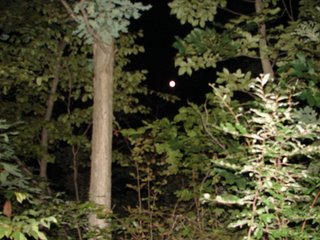 Native Americans measure the year in moons, not in months, as is well known. At least one tribe calls what we name September as the Moon When the Birds Fly Away. I am really seeing the truth of that this week. Looking out my office window the past two days I see flocks of starlings and others that I can’t identify without binoculars swirling around the sky, like so many spots of pepper.
Native Americans measure the year in moons, not in months, as is well known. At least one tribe calls what we name September as the Moon When the Birds Fly Away. I am really seeing the truth of that this week. Looking out my office window the past two days I see flocks of starlings and others that I can’t identify without binoculars swirling around the sky, like so many spots of pepper.I’ve heard reports of large warbler fallouts—not at the cabin, unfortunately. A warbler “fallout” is when large numbers and many species of these tiny and beautiful birds all end up in the same place at the same time. A fallout most often happens on tops of mountains or on both sides of a large body of water that the poor things have to fly over. A fallout on the shore before a big water flight is to fuel up with insects, rest and perhaps to work up the nerve to start. A fallout after a big water flight is to rest and eat. Sometimes, the birds are so exhausted they all but fall out of the sky when they finally reach land. Fallouts on tops of mountains are rest stops and eating stops. It probably takes less energy to drop just a few hundred feet in altitude and refuel on the top of a mountain than it does to fly into a valley. It’s kind of like a gas station right at the on/off ramp of an interstate.
Broad-winged hawk reports for yesterday in this area were pretty impressive for so early in the season. Several of the local hawkwatches tallied more than 1,000 broadwings. The timing of the broadwing hawk migration is usually quite predictable, weather permitting. In my area of southern Pennsylvania, it you want to see broadwings, you should be on a lookout on the 17-18th of September. Historically, those are the days most likely to be the big migration days for this species. This is not to say you won’t see them a week before or after these dates. But the biggest flight is usually on these days.
Weather does affect the migration. One of the biggest flights ever in this area was September 12, 1978 at Hawk Mountain when more than 12,000 birds flew past. But this amazing result preceded 10 days of serious rain and poor flight conditions. Those birds pretty much had no other window of flight opportunity, and they knew it, so they migrated early.
This year, the prediction is for poor flight conditions through Friday (the 15th) but clear weather is predicted after that, so the 1,000+ birds seen at several lookouts yesterday is a little surprising to me. The other interesting pattern was that the flight was better to the west than in the east. Waggoner’s Gap near Carlisle had 1,300 broadwings, while Bake Oven Knob in Schuykill County (or is it Berks??) had 1,100. The Philadelphia region hawkwatches had less than 100 broadwings. This is likely due to the lack of northwest winds this week. The birds haven’t been pushed to the east and have been able to follow a more direct flight path. Of course, that might change after the rain finally clears the region.








1 comment:
A really worthy post. Thanx!
Post a Comment